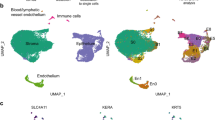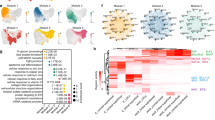Abstract
Replying to: T.-T. Sun, S. C. Tseng & R. M. Lavker Nature 463, 10.1038/nature08805 (2010)
Our claim is not that there are no stem cells in the limbus, but that there is more to corneal renewal than the limbus and that the double-dome-shaped structure of the cornea and physical constraints have a crucial impact on cell dynamicshttps://www.nature.com/articles/nature088051.
Similar content being viewed by others
Main
Sun and colleagues2 imply that in our paper3 we misused the term ‘holoclones’ that we defined as stem cells4; the central cornea of the pig contains numerous true holoclones, meaning that the cornea of the pig has extensive growth potential and the ability to be serial passaged in vitro. We agree that there are species differences among mammals; nonetheless, all corneas that we have investigated, including calf and human, contain colony-forming cells. Fifty cell doublings in pig cornea is not trivial and contradicts the model proposed by Sun and colleagues5; we quote their abstract “we demonstrate the existence of a hierarchy of TA cells; those of peripheral cornea undergo at least two rounds of DNA synthesis before they become post-mitotic, whereas those of central cornea are capable of only one round of division”. It also does not agree with Huang and Tseng’s experiment6 showing “that, after limbal removal, rabbit central corneal epithelium can remain apparently intact for a long time until it is wounded, indicating that central cornea cells have a significant maintenance potential”.
Our results show that corneal cells can form goblet cells when they migrate onto a conjunctival environment (in mouse) or generate true goblet cell colonies when cloned (in pig). Corneal differentiation is found in human conjunctiva7, conjunctival cells may be successfully transplanted in the human to replace cornea8, and there are reports of cornea remaining transparent for years in limbal deficiency9. Furthermore, corneal cells10, like conjunctival cells (our unpublished results), can form hairy skin when exposed to an inductive skin microenvironment, indicating a greater plasticity than anticipated and that stem cell fate strongly depends on stromal signals.
We are not aware of any paper that clearly demonstrates stem cell migration from the limbus. Buck11 in his landmark paper has not demonstrated basal cell migration; we quote his abstract: “the median distance migrated was about 17 μm per day. This figure represents the distance through which superficial and wing cells had migrated; the distance migrated by basal cells was not determined”. Nagazaki and Zhao12 have presented evidence of movement in the cornea but not that the migrating cells actually originated from the limbus (‘from’ is not the same as ‘near’). An overcrowding of the corneal epithelium, a source of tension and sliding as previously emphasized by Sun and colleagues13, or sequential activation of the β-actin promoter can easily explain these observations. Similarly, the spiral stripe organization mixing clockwise and counterclockwise clones14 is highly reminiscent of centrifugal growth originating from a small number of stem cells originally located in central cornea. This biological model occurs widely in nature, for instance in the growth of a daisy, as the easiest and most efficient way to fill space, a notion supported by mathematical models15 and a clothoid growth model (Euler spiral).
References
Dupps, W. J. & Wilson, S. E. Biomechanics and wound healing in the cornea. Exp. Eye Res. 83, 709–720 (2006)
Sun, T.-T., Tseng, S. C. & Lavker, R. M. Location of corneal epithelial stem cells. Nature 463 10.1038/nature08805 (2010)
Majo, F., Rochat, A., Nicolas, M., Jaoude, G. A. & Barrandon, Y. Oligopotent stem cells are distributed throughout the mammalian ocular surface. Nature 456, 250–254 (2008)
Barrandon, Y. & Green, H. Three clonal types of keratinocyte with different capacities for multiplication. Proc. Natl Acad. Sci. USA 84, 2302–2306 (1987)
Lehrer, M. S., Sun, T. T. & Lavker, R. M. Strategies of epithelial repair: modulation of stem cell and transit amplifying cell proliferation. J. Cell Sci. 111, 2867–2875 (1998)
Huang, A. J. & Tseng, S. C. Corneal epithelial wound healing in the absence of limbal epithelium. Invest. Ophthalmol. Vis. Sci. 32, 96–105 (1991)
Kawasaki, S. et al. Clusters of corneal epithelial cells reside ectopically in human conjunctival epithelium. Invest. Ophthalmol. Vis. Sci. 47, 1359–1367 (2006)
Di Girolamo, N. et al. A contact lens-based technique for expansion and transplantation of autologous epithelial progenitors for ocular surface reconstruction. Transplantation 87, 1571–1578 (2009)
Dua, H. S., Miri, A., Alomar, T., Yeung, A. M. & Said, D. G. The role of limbal stem cells in corneal epithelial maintenance: testing the dogma. Ophthalmology 116, 856–863 (2009)
Ferraris, C., Chevalier, G., Favier, B., Jahoda, C. A. & Dhouailly, D. Adult corneal epithelium basal cells possess the capacity to activate epidermal, pilosebaceous and sweat gland genetic programs in response to embryonic dermal stimuli. Development 127, 5487–5495 (2000)
Buck, R. C. Measurement of centripetal migration of normal corneal epithelial cells in the mouse. Invest. Ophthalmol. Vis. Sci. 26, 1296–1299 (1985)
Nagasaki, T. & Zhao, J. Centripetal movement of corneal epithelial cells in the normal adult mouse. Invest. Ophthalmol. Vis. Sci. 44, 558–566 (2003)
Lavker, R. M. et al. Relative proliferative rates of limbal and corneal epithelia. Implications of corneal epithelial migration, circadian rhythm, and suprabasally located DNA-synthesizing keratinocytes. Invest. Ophthalmol. Vis. Sci. 32, 1864–1875 (1991)
Collinson, J. M. et al. Clonal analysis of patterns of growth, stem cell activity, and cell movement during the development and maintenance of the murine corneal epithelium. Dev. Dyn. 224, 432–440 (2002)
Stewart, I. Mathematical recreations: Daisy, Daisy, give me your answer, do. Sci. Am. 272, 96–99 (1995)
Author information
Authors and Affiliations
Ethics declarations
Competing interests
Competing financial interests: declared none.
Rights and permissions
About this article
Cite this article
Majo, F., Rochat, A., Nicolas, M. et al. Majo et al. reply. Nature 463, E11 (2010). https://doi.org/10.1038/nature08806
Issue Date:
DOI: https://doi.org/10.1038/nature08806
Comments
By submitting a comment you agree to abide by our Terms and Community Guidelines. If you find something abusive or that does not comply with our terms or guidelines please flag it as inappropriate.



